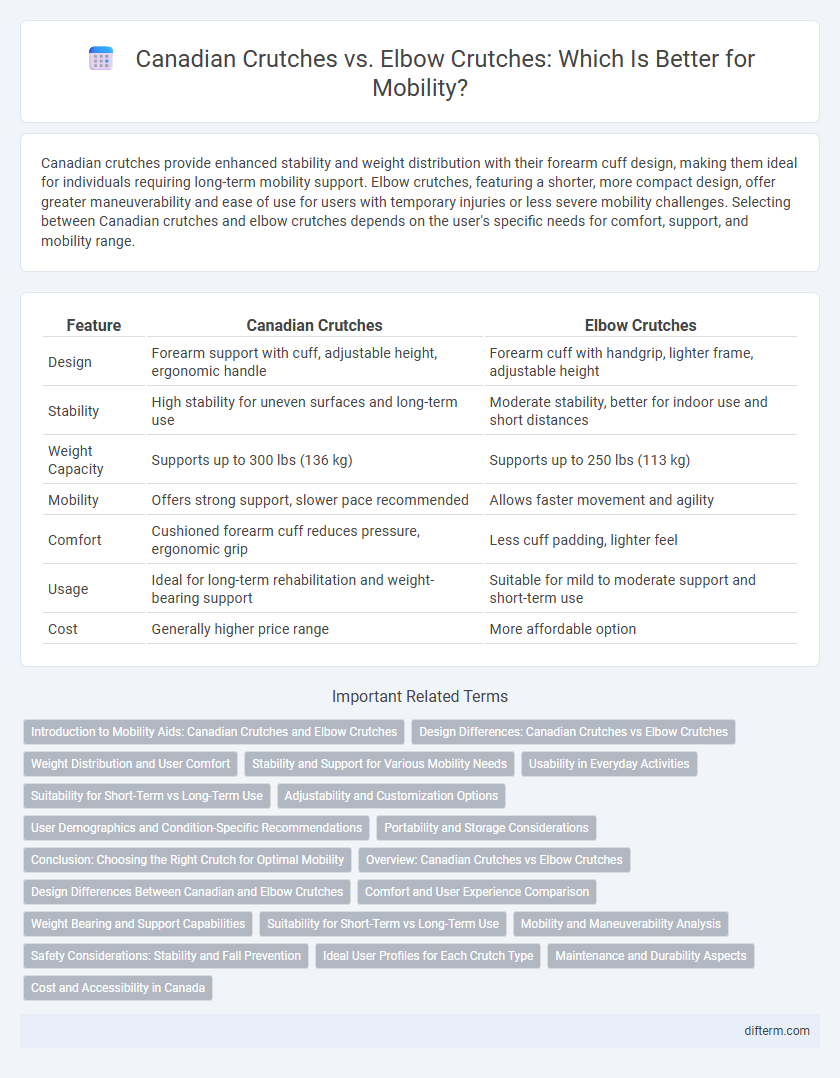Canadian crutches provide enhanced stability and weight distribution with their forearm cuff design, making them ideal for individuals requiring long-term mobility support. Elbow crutches, featuring a shorter, more compact design, offer greater maneuverability and ease of use for users with temporary injuries or less severe mobility challenges. Selecting between Canadian crutches and elbow crutches depends on the user's specific needs for comfort, support, and mobility range.
Table of Comparison
| Feature | Canadian Crutches | Elbow Crutches |
|---|---|---|
| Design | Forearm support with cuff, adjustable height, ergonomic handle | Forearm cuff with handgrip, lighter frame, adjustable height |
| Stability | High stability for uneven surfaces and long-term use | Moderate stability, better for indoor use and short distances |
| Weight Capacity | Supports up to 300 lbs (136 kg) | Supports up to 250 lbs (113 kg) |
| Mobility | Offers strong support, slower pace recommended | Allows faster movement and agility |
| Comfort | Cushioned forearm cuff reduces pressure, ergonomic grip | Less cuff padding, lighter feel |
| Usage | Ideal for long-term rehabilitation and weight-bearing support | Suitable for mild to moderate support and short-term use |
| Cost | Generally higher price range | More affordable option |
Introduction to Mobility Aids: Canadian Crutches and Elbow Crutches
Canadian crutches and elbow crutches serve as essential mobility aids designed to provide support and stability for individuals with lower limb impairments. Canadian crutches, featuring handgrips and forearm support, offer enhanced control and weight distribution, making them suitable for users requiring moderate to significant assistance. Elbow crutches, characterized by a cuff around the forearm and a handgrip, prioritize ease of use and maneuverability, often preferred for long-term use due to their ergonomic design and reduced strain on the wrists.
Design Differences: Canadian Crutches vs Elbow Crutches
Canadian crutches feature a forearm cuff and a handgrip designed to provide more support and stability, promoting weight distribution along the forearm, ideal for long-term use. Elbow crutches, also known as forearm crutches, have a lower cuff around the forearm and a handle closer to the body, allowing for greater mobility and maneuverability in tight spaces. The design differences impact user comfort, load-bearing capacity, and suitability for various mobility challenges.
Weight Distribution and User Comfort
Canadian crutches provide superior weight distribution by transferring pressure from the hands to the forearms, reducing strain on wrists and improving stability. Elbow crutches offer less weight-bearing support on the arms but allow greater mobility and maneuverability due to their streamlined design. Users often find Canadian crutches more comfortable for prolonged use, while elbow crutches are preferred for lighter support needs and increased range of motion.
Stability and Support for Various Mobility Needs
Canadian crutches provide enhanced stability and superior weight distribution, making them ideal for users who require robust support and balance during mobility. Elbow crutches offer greater maneuverability and are well-suited for individuals needing moderate support with more arm freedom and flexibility. Both crutch types cater to different mobility needs by balancing support levels and user comfort based on injury severity and terrain.
Usability in Everyday Activities
Canadian crutches offer greater stability and weight distribution, making them suitable for users needing robust support during longer periods of use, especially when navigating uneven surfaces or carrying items. Elbow crutches provide enhanced maneuverability and ease of use in confined spaces, allowing for smoother movement in daily activities like household chores or shopping. Choosing the right crutch depends on balancing the need for stability with the ease of handling in various everyday environments.
Suitability for Short-Term vs Long-Term Use
Canadian crutches, also known as forearm crutches, offer enhanced support and are better suited for long-term mobility needs due to their ergonomic design and improved weight distribution. Elbow crutches, typically lighter and easier to maneuver, are ideal for short-term use, providing sufficient stability during recovery periods without prolonged strain on the arms. The choice between Canadian crutches and elbow crutches largely depends on the user's anticipated duration of use and level of mobility support required.
Adjustability and Customization Options
Canadian crutches offer extensive adjustability with multiple height settings and cushioned hand grips, enabling personalized comfort for varied user needs. Elbow crutches provide limited customization, primarily featuring adjustable height but fewer options for handgrip modifications. Choosing between the two depends on the required level of adaptability and user-specific ergonomic preferences.
User Demographics and Condition-Specific Recommendations
Canadian crutches are often preferred by users with longer-term mobility impairments or those requiring greater weight-bearing support, such as individuals recovering from lower limb surgeries or managing arthritis. Elbow crutches better serve younger, active users or individuals with upper limb strength and balance challenges, providing increased maneuverability and independence. Specific conditions like spinal cord injuries or stroke may dictate customized crutch selection based on user balance, strength, and rehabilitation goals.
Portability and Storage Considerations
Canadian crutches offer lightweight construction and foldable features, making them highly portable and easy to store in compact spaces such as car trunks or small closets. Elbow crutches, although bulkier with extended arm supports, often come with adjustable components that can be disassembled for storage but require more space than Canadian crutches. For users prioritizing convenience during travel or urban mobility, Canadian crutches provide superior portability and simpler storage solutions compared to elbow crutches.
Conclusion: Choosing the Right Crutch for Optimal Mobility
Canadian crutches provide superior weight distribution and enhanced stability, making them ideal for individuals requiring long-term mobility support and reducing strain on wrists and hands. Elbow crutches offer greater maneuverability and ease of use in tight spaces, suitable for short-term recovery or active users needing moderate support. Selecting the right crutch depends on the user's mobility goals, physical condition, and daily activity demands to ensure optimal comfort and effectiveness.
canadian crutches vs elbow crutches Infographic

 difterm.com
difterm.com